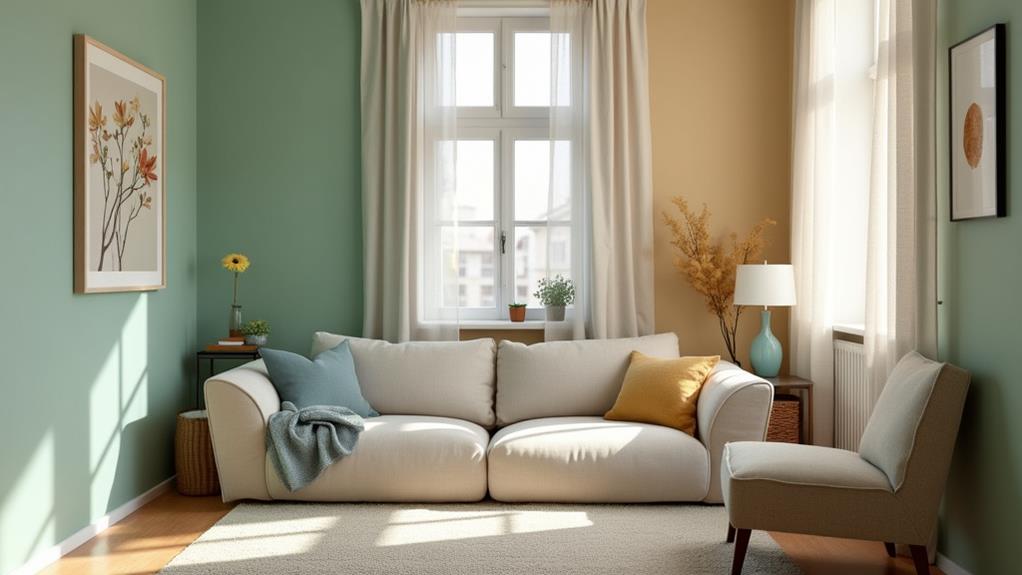To maximize the feel of your small space, color choices are key. Light, cool or neutral colors – such as blues, greens, whites, or grays – reflect light and make rooms seem more open and airy. Conversely, dark hues add depth, warmth and sophistication when used strategically. Overall, it's about balance: Combine light and dark tones, ensuring vibrant shades complement rather than overpower. Your chosen scheme should reflect both your personality and the room's purpose to create a harmonious, functional space. There's so much more to uncover about clever compositions, lighting tips and decor tricks that can dramatically alter your room's perception.
Understanding Color Psychology in Small Rooms

Grasping the psychology of color in small rooms can transform your space from cramped to cozy. You're not just picking hues that appeal to your personal taste, but ones that can influence your mood, perception and overall experience within a small space.
Think about how you want your room to feel. Do you want it to be a calming sanctuary or an energizing workplace? Colors have the power to evoke these feelings.
Cool colors like blues and greens are known to create a serene, tranquil environment. They're perfect for a bedroom or a reading nook where you'd want to relax.
On the other hand, warm colors like reds, oranges, and yellows can stimulate and invigorate. They're excellent choices for a home office, a gym, or any space where you need to stay active and motivated.
You might think that dark colors could make your room feel smaller, but if used effectively, they can add depth and create a cozy atmosphere.
Understanding color psychology isn't just about aesthetics; it's about creating a room that works in harmony with your lifestyle and needs.
The Impact of Light Colors on Small Spaces
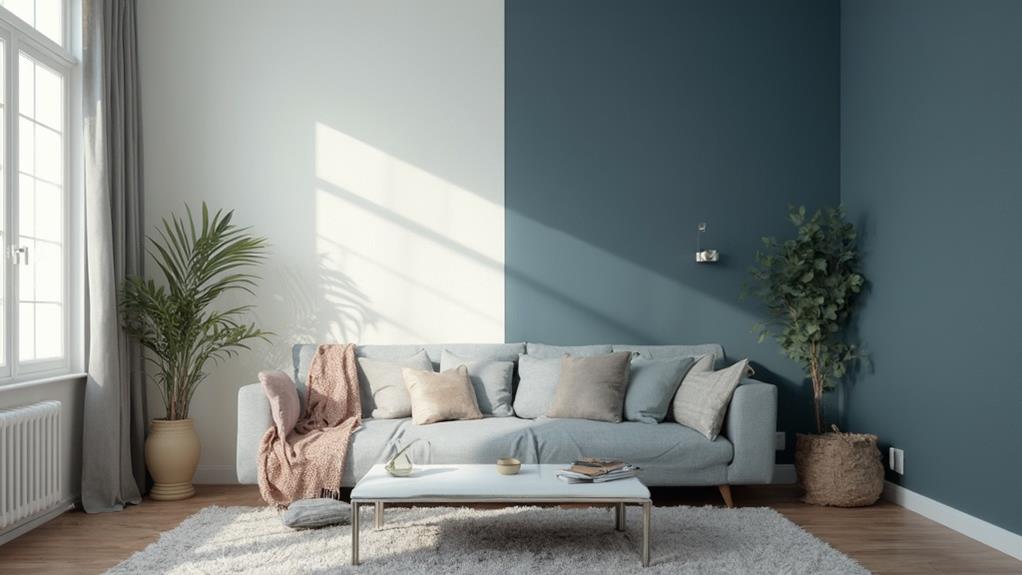
Imagine stepping into a small room bathed in light color. Instantly, you're enveloped by a sense of openness, a refreshing atmosphere.
Light colors have a magical way of making small spaces feel larger. Why? It's all about light reflection. Lighter shades reflect more light, giving the illusion of extra space. Cool hues like blues, greens, and lavenders can make a room seem expansive and serene.
Let's dive a bit deeper. You'll notice that light colors not only make a room feel bigger, but also brighter. They're ideal for rooms with little natural light. They bounce off the minimal light available, maximizing its effect, and creating a luminous ambiance.
Furthermore, light colors offer a neutral backdrop that allows your furnishings and décor to take center stage. They're versatile and timeless, and provide a calming effect, perfect for areas of relaxation like bedrooms or reading nooks.
Dark Colors Role in a Home Makeover

While you might think dark colors have no place in a small room, they can actually play an essential role in a home makeover. Contrary to popular belief, dark hues can add depth and dimension, creating an illusion of grandeur. For example, a dark accent wall can draw the eye and make the room appear larger than it actually is.
You should also consider the mood you're aiming to create. Dark colors, such as deep blues or rich browns, can add a sense of sophistication and warmth to a space. They're perfect for creating a relaxing, cozy atmosphere in a bedroom or a dramatic, elegant vibe in a dining area.
However, it's vital to strike a balance. Too many dark colors can make a room feel overwhelming and claustrophobic. Pair them with lighter colors or use them sparingly as accents to avoid this.
Choose furniture and decor in lighter shades to contrast and highlight the dark colors. Finally, make sure you have adequate lighting to prevent the room from feeling gloomy.
Neutral Colors: A Safe Bet for Small Rooms

Dipping your walls in neutral colors can be the key to creating a sense of spaciousness in a small room. The beauty of neutral colors lies in their versatility. They're not demanding, yet they provide a calm, serene backdrop that makes a room feel larger and brighter.
Neutrals like white, cream, beige, and gray are often considered the go-to shades for small spaces. They reflect light, making your room appear airy and open.
But that's not all! Neutrals also give you the freedom to play around with your decor. You can mix and match furniture, art, and accessories without the risk of clashing colors.
You might think neutral equals boring, but that's not the case. By adding texture through materials like wood, metal, or fabric, you can create interest and depth.
And don't forget about patterns! A striped rug or chevron throw pillow can inject a dash of dynamism without overwhelming the space.
Successful Color Combinations for Small Spaces
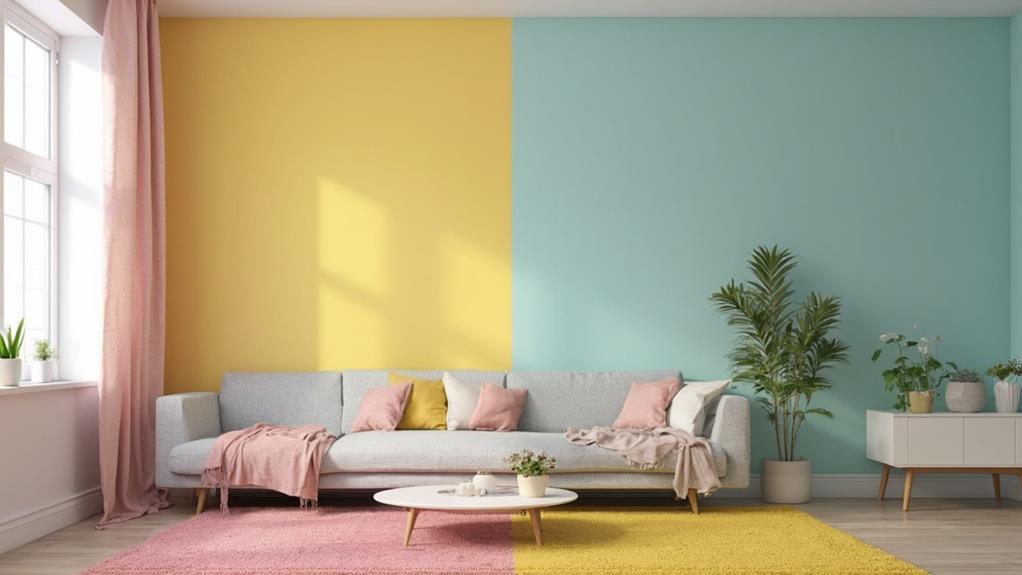
Even though your space might be small, that doesn't mean you're limited in your color choices. In fact, the right color combinations can make a significant impact on how your space feels.
One successful combination for small rooms is pairing a lighter color with a darker accent color. For instance, baby blue walls with a navy accent wall can create depth and interest without overpowering the room.
You can also combine warm and cool colors to create balance. For instance, a light green (cool) can pair well with a warm beige. This combination creates a soothing, harmonious atmosphere.
Don't be afraid to use brighter colors either. A pop of bright yellow or bold red can add personality to your space.
However, moderation is key. Use these vibrant colors sparingly and complement them with neutral tones to avoid overwhelming your space.
Creating Room Size Illusion With Paint Colors
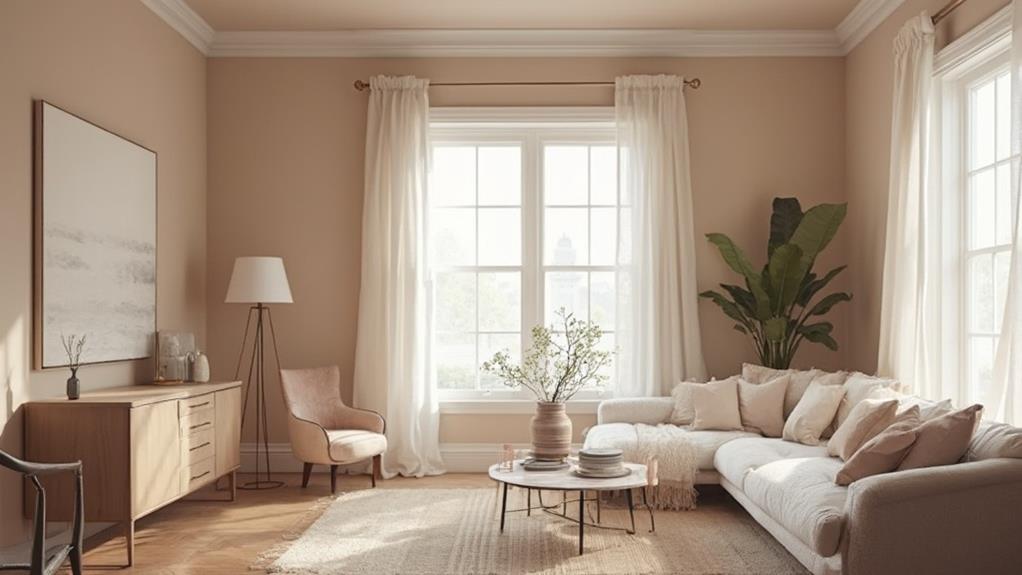
In the domain of small spaces, the strategic use of paint colors can create the illusion of a larger room. You'd be amazed at how a simple splash of paint can change your perception of space.
Choosing light colors is the first step. They reflect light, making a room feel open and airy. Whites, creams, and pastels are ideal choices. You might think it's boring, but they're actually a perfect canvas for your furniture and decorations.
Don't shy away from using darker colors as an accent. They can add depth and give the impression of receding walls. Just don't overdo it, or you'll risk making the room feel smaller.
Here's a pro-tip: Paint your ceiling a lighter color than your walls. It draws the eye upward, which gives the illusion of height. If you're daring, go for a mirror finish. It'll amplify the effect.
Home Makeover: Accessories and Lighting Tips
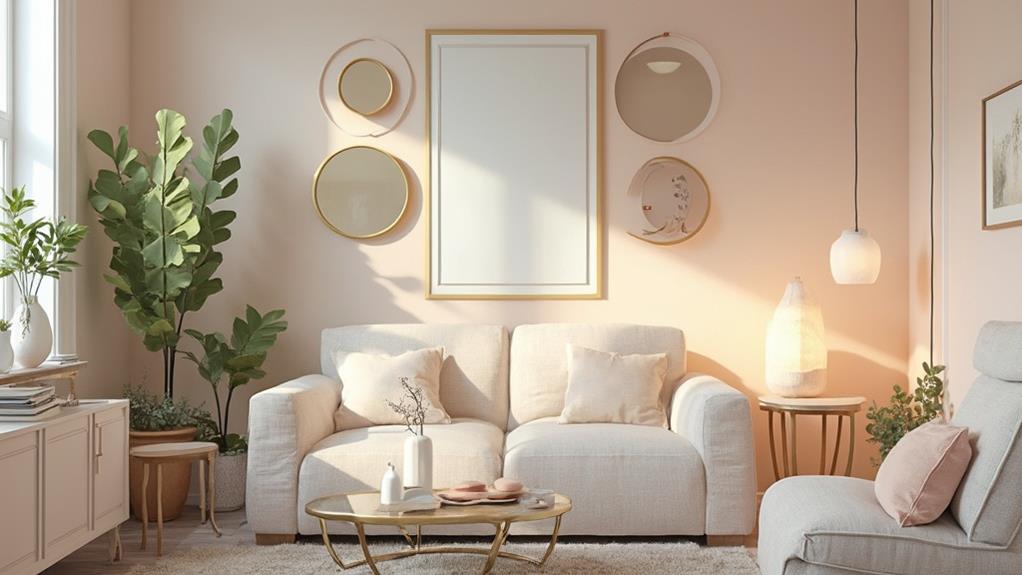
A handful of well-chosen accessories and the right lighting can drastically transform your small room. Accessories can add personality, while lighting sets the mood.
Here's how you can work them to your advantage:
Consider mirrors as your first go-to accessory. They're not just for checking your look; mirrors reflect light and make a room appear larger. Place them opposite a window or lamp for maximum effect.
Rugs are also great. They define areas without taking up space. Go for bold patterns to add depth and interest. Try incorporating new lighting fixtures, like table or floor lamps, for an added touch of warmth and style.
Now, let's talk lighting. It's essential in small spaces. Overhead lighting can be harsh and create shadows. Instead, use multiple light sources.
Consider table lamps or wall sconces to distribute light evenly. A floor lamp can also work wonders, adding height and dimension.
And don't forget about natural light. Maximize it as much as you can. Use light, reflective curtains or blinds that let sunshine in while offering privacy.
Incorporating Color Schemes for Room Size Illusion

Choosing the right color scheme can dramatically alter your perception of a small room's size. You've probably heard that light colors make a room look larger and darker ones make it feel smaller. But, it's not just about picking a light color. It's how you use it.
Focus on creating a monochromatic color scheme. This cuts down on visual clutter, making your space feel more open and airy.
To create depth, use different shades of the same color. Lighter shades can be used on the walls, while darker ones can go on trims and doors. This tricks the eye into thinking the room is larger.
Don't forget your ceiling! Painting it a lighter shade than the walls can create the illusion of height. Just as horizontal stripes can make you look wider, vertical ones can make your room look taller.

